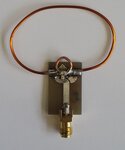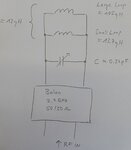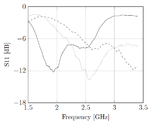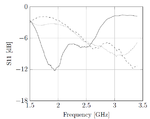membran
Newbie level 6
Dear Community
I've designed a very simple loop antenna for 2.5 GHz (see image). The PCB was thereby given from a previous project.

The smaller loop is used to lower the inductance, in order to achieve a resonant circuit with the variable capacitor I've soldered in parallel with the loop terminals. In theory, resonance should be present around 2.4 GHz, and the structure should have an impedance of 50 Ohm there. Afterwards, the antenna is connected to a 2.4 Ghz 50/50 Ohm balun.
At the balun input however, I measure an impedance of 20-j20 Ohm. Why does the manufacturer specify both the input and output impedance of the balun? Is it likely that something with the impedance matching of the antenna went wrong (since I cant measure 50 Ohm at the balun input)?
Regards,
Membran
I've designed a very simple loop antenna for 2.5 GHz (see image). The PCB was thereby given from a previous project.

The smaller loop is used to lower the inductance, in order to achieve a resonant circuit with the variable capacitor I've soldered in parallel with the loop terminals. In theory, resonance should be present around 2.4 GHz, and the structure should have an impedance of 50 Ohm there. Afterwards, the antenna is connected to a 2.4 Ghz 50/50 Ohm balun.
At the balun input however, I measure an impedance of 20-j20 Ohm. Why does the manufacturer specify both the input and output impedance of the balun? Is it likely that something with the impedance matching of the antenna went wrong (since I cant measure 50 Ohm at the balun input)?
Regards,
Membran


